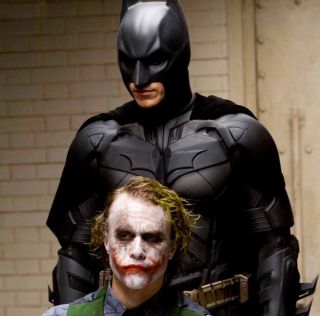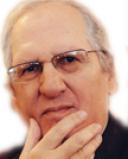Anger
Nightmare in Aurora: Batman, the Joker and James Holmes
Rage, violence and the psychology of evil.
Posted July 24, 2012

In The Dark Knight (2008), the Batman movie preceding the newly released The Dark Knight Rises, the late Heath Ledger plays the Joker: the ultimate psychopathic, antisocial, nihilistic, manipulative evil villain. Indeed, the director of these popular films, Christopher Nolan, has aimed not only to entertain but to try to address the psychology of human evil. Where does evil come from? What causes it? Are some people born evil? Is evil a kind of mental illness? Or is it an existential choice? Do we all carry the innate capacity for evil? Or is human nature basically good and evil a rare neurobiological aberration?
In the aftershock of what happened in Aurora, Colorado just after midnight on Friday, these existential, psychological and spiritual questions become even more relevant. Viewing violence and evil from a distant, comfortable seat in a cinema eating popcorn is one thing. But when evil leaps suddenly from the safety of some movie, television, cell phone or computer screen into real life, as it did literally at the film's eagerly awaited opening, it is a deadly, surreal and shattering experience. Not only for the unfortunate victims and first-hand witnesses of this grotesque debacle, but for everyone. Not only for Americans but for the entire world. It is, even now, as if we are still watching a Batman movie from afar, but know that it is not fantasy, CGI and special effects we are witnessing but harsh reality. Again. And again. In Colorado. Norway. Arizona. Virgina. The terrifying reality of evil. The devastating madness of violence.

We have been increasingly seeing more of these violent explosions in recent decades. (See my prior posts.) This methodical madness. What prompts a reportedly academically brilliant, introverted, quiet, polite and mild-mannered church-going 24-year-old doctoral student in neuroscience to perform poorly on his exams, precipitously quit graduate school, allegedly dress up like some cross between Batman and Darth Vader (sans cape) in black body armor, (gas) mask and helmet, arm himself to the teeth with automatic weapons, a shotgun and tear gas cannisters, and calmly open fire in a crowded movie theater, killing 12 and wounding 58, including children? (See my follow-up posting on this case here.)

Curiously, though fitted out a little like the Batman character, the suspect had dyed his hair bright orange and referred to himself as the Joker when arrested in the parking lot right after his bloody rampage. Holmes even allegedly left an elaborately Joker-like explosive booby-trap at his apartment for unsuspecting investigators to find, in an apparent effort to exact even more carnage and chaos in the event he was killed or apprehended. Might there be some symbolic meaning in such madness? Did James Holmes deeply identify with the Joker?
In The Dark Knight, billionaire playboy Bruce Wayne, played by Christian Bale, learns—like Luke Skywalker in the Star Wars saga—to wrestle and courageously come to terms with his inner demons, his dark side, his fears, sexuality, selfishness, and his resentment, bitterness, hatred, his vengeful rage. Out of this arduous personal struggle (not unlike the psychotherapy process) Batman is born. And so begins his heroic career fighting the forces of evil. Bruce Wayne has more or less learned to channel and redirect his darkest daimonic impulses, especially his anger regarding having traumatically witnessed the brutal murder of his parents as a boy, into constructive and creative activity. He becomes—he creates—a superhero. The so-called caped crusader of Gotham. Though, clearly, he is still haunted by his demons (the daimonic) and sometimes has trouble controlling them. Bruce Wayne, Batman's Clark Kent-like public persona, like all of us, still has a dark and powerful shadow. But he has consciously and heroically harnessed his daimonic energies to stand up to evil in the world rather than give in to or ignore it. Batman is the embodiment of Bruce Wayne's shadow put to positive use in society. This is one of life's greatest challenges. It is far easier to distinguish oneself by doing evil than good, to be destructive rather than creative. To settle, like many mass murderers, for facile infamy in lieu of far more elusive legitimate recognition, success or fame. Most mass murderers are in part driven by a wicked rage for recognition. (See my prior post.)

On the other hand, Batman's cruel counterpoint, his nemesis, his antithesis, the Joker, has completely given in to his shadow. He has embraced evil: the sadistic infliction of suffering on society. He has no values, no rules, no morals, no scruples, no empathy, no compassion and no conscience. He seeks only self-satisfying destructiveness via violence. He has been taken over. Pathologically possessed by the shadow. Fallen victim to and driven by his darkest demons. The Joker is the evil Mr. Hyde to Batman's good Dr. Jekyll. But as he himself suggests, Joker and Batman need each other, because they represent two eternally conflicting and counterbalancing, opposite sides of human potentiality: moral vs. immoral, constructive vs. destructive, good vs. evil. Together they comprise a whole human being and the whole of life. One would not exist without the other. In Jungian terms, we could say that the Joker represents Batman's archetypal shadow: the innate capacity for radical evil which exists in each and every one of us. The most destructive, depraved and devastating expression of the daimonic. It is precisely this radical evil we see being manifested so horrifically in this most recent in an alarming and escalating series of mass shootings here and abroad. (See my prior posts.)
And what made the Joker, with his hideously deformed indelible sardonic smile the sick, depraved and demonic man he is? Was he simply born bad? Well, he himself answers that crucial question, not once but twice, in The Dark Knight. He first explains that he had been married and in love at one time:
So, I had a wife, she was beautiful ... like you, who tells me I worry too much, who tells me I oughta smile more, who gambles and gets in deep with the sharks ... Hey. One day they carve her face. And we have no money for surgeries. She can't take it. I just want to see her smile again. Hmmm? I just wanted to let her know that I don't care about the scars. So, I stick a razor in my mouth and do this ... to myself. [mimes moving a razor around his mouth] And you know what? She can't stand the sight of me! She leaves! Now I see the funny side. Now, I'm always smiling!
So the source of the Joker's evil and destructiveness was being a loving, caring, deeply empathic, self-sacrificing husband painfully abandoned by the woman he worshipped. And, even more importantly, his anger, rage and embitterment about this traumatic rejection.
He then, ever the trickster, tells a totally different story:
Wanna know how I got these scars? My father was ... a drinker. And a fiend. And one night he goes off crazier than usual. Mommy gets the kitchen knife to defend herself; he doesn't like that. Not ... one ... bit. So, me watching, he takes the knife to her, laughing while he does it. He turns to me, and says ... "Why so serious?" He comes at me with the knife, "Why so serious?!" He sticks the blade in my mouth, "Let's put a smile on that face!"
Here his wounding comes much earlier, from his alcoholic father, for whom he had to put on a constantly happy face or face his drunken wrath. In either or both cases, the sensitive person became the Joker because of severe trauma during childhood and/or traumatic loss during adulthood. And, most importantly, his resulting rage in reaction to trauma, abandonment and loss. This is a key to understanding what motivates many mass murderers and their underlying psychopathology. Psychoanalyst Otto Kernberg writes that such anger, rage, resentment and hatred is "the core affect of severe psychopathological conditions, particularly severe personality disorders, perversions, and functional psychoses." (p. 21) And he is correct. Mass shootings like the one in Colorado tend to be an unconscious or semi-conscious acting out of chronically repressed resentment, embitterment and anger toward parents, society, world, God and, sometimes, self. Often such angry individuals try to consciously put on a "happy face," be nice, polite, spiritual or religious while beneath the surface, behind their permanently smiling public persona or mask, their rage roils and festers. They try their best to play by the rules of society. To be good and kind and law-abiding. Until something happens that finally triggers their repressed rage and activates their antisocial shadow. They are often not sociopaths or psychopaths by history. Quite the contrary.
Symbolically speaking, the Joker is a personification of the archetypal "trickster," which, according to C.G. Jung (1954) "is represented by counter-tendencies in the unconscious, and in certain cases by a sort of second personality, of a puerile and inferior character ... I have, I think, found a suitable designation for this character-component when I called it the shadow."(See my prior post on the "shadow.") Jung goes on to say, "The so-called civilized man has forgotten the trickster. He remembers him only figuratively and metaphorically, when, irritated by his own ineptitude, he speaks of fate playing tricks on him or of things being bewitched. He never suspects that his own hidden and apparently harmless shadow has qualities whose dangerousness exceeds his wildest dreams. As soon as people get together in masses and submerge the individual, the shadow is mobilized, and, as history shows, may even be personified and incarnated."
For the victims of this monstrosity, their families and friends, and for all the rest of us who are vicariously victimized by such evil deeds, what took place in that movie theater in Aurora was and still is a nightmare. (See my prior post on "The Trauma of Evil.") Like some awful dream. But, as with all but the most impulsive and unpremeditated murderous acts, it began as a dream or fantasy born in the obviously twisted and troubled psyche of the alleged perpetrator prior to carrying it out. It existed for some time as a fantasy for which detailed preparations were apparently made over the course of months. Which is why I thought it might be interesting to analyze what happened in much the same way we would analyze a nightmare brought in by a patient in psychotherapy. What if we were to look for a moment at what transpired this week in Colorado, with its undeniably surreal, mythic and symbolic quality, as though it were a bad dream? How might we try to psychologically understand such a murderous nightmare? (See my review of the film Inception.)
As a psychotherapist, the unbidden appearance of such a dream would indicate to me that the unconscious, the "shadow" has been activated, and symbolized in the dark clad hybrid of Batman and Darth Vader. Interestingly, like the shadow or daimonic, this figure is an amalgamation of both evil and good, heroism and villainy, positive and negative potentialities. So we are speaking of the daimonic here, which, by definition, is both destructive and constructive, depending upon how we deal with it. The actions of this shadowy trickster figure suggests the presence of long-festering resentment, anger, homicidal rage. A fury that needs to be made conscious and constructively expressed. Without such acknowledgment and expression of the patient's denied and dissociated aggression, it is more likely to be acted out in the external world. Or "acted in," in the form of depression or even suicide. To take destructive possession of the entire personality.
Another important point would be how the patient reacts emotionally to having had this dream: Is it disturbing or what we psychologists call egodystonic? Or not. If the patient enjoyed the dream, found it to be egosyntonic, taking sadistic pleasure in having such absolute power over the lives of others, there might be even more reason for concern and the possibility of living out such a dream. However, clearly, for most of us, such a dream would be egodystonic and distressing. The part of ourselves Jung called the "shadow" is almost always disturbing and experienced as alien to our conscious personality and ego. But such dreams can be had by anyone. And frequently are.
For example, here is a dream one of my former patients reported during the course of his treatment:
"I had this wild dream last night. ... I wasn't going to tell you. ... It was so ugly ... I was afraid to tell you. In my dream, I wanted to see what it was like to kill; so I took my shotgun and wiped out twelve little kids [ages five or six]. ... It was such a random act of violence that nobody had a clue where to start looking, why it was done or who did it. There were no traces. I kept vacillating back and forth whether to keep my mouth shut and go on living with the demons: It was obviously haunting, because I was ashamed and disgraced with what I did. Another option was to spend my life in prison; or to go on and try to live with it, come to terms with having made a horrible mistake. I came in to you to talk about it. ... The big struggle for me was to tell the truth or not tell the truth; or, could I go on and live with something like that. . ... What I got out of [the dream] is that there's this dark side to me—to everyone—and acting on it and then taking responsibility for it was the question: whether I would do that or not. [In the dream] I chose not to. I chose to flee from it. ... The dark side was very powerful. I let it go and then I wished I hadn't."
The "dark side"—the "shadow" or what Rollo May called the daimonic—is very powerful. Clinically, this is always cause for concern. How are we to interpret and respond to this patient's deeply disturbing dream? In this case, the fact that my patient had this nightmare, this unsettling, vivid inner vision of violence, mayhem and random murder—which, only after some hesitation, he chose to share with me—did not necessarily cause me to presume any conscious intentions of carrying it out in reality. Dreaming is different from doing.Though as a clinician, one is always obliged to soberly explore such very real destructive potentialities, and painstakingly rule them out as best one can. In my experience, it is more often the case that expressing the daimonic or shadow, the dark side, in dreams (i.e., the subjective inner theater of the imagination) actually lessens the likelihood of patients needing to compulsively act it out. But what happened in Colorado, Virginia, Arizona, in Norway is the acting out in reality of such fantasies. (See, for example, my prior post on Anders Breivik.) However, the homicidal fantasies almost always precede the act in such cases, which is what makes them premeditated as opposed to purely impulsive crimes of passion. But in both cases, underlying pathological anger, rage and hatred drive the destructive behavior.
The daimonic—like human nature itself—is always an admixture of positive and negative, evil and good, destructiveness and creativity. This is the unvarnished existential truth about human potentiality. According to the report of friends, James Holmes for some reason they couldn't comprehend always sympathized, identified with and rooted for the evil villains in films like the Batman series. For the anti-hero. What might this tell us about someone's psyche? While I cannot speak to this defendant's state of mind specifically, and proffer no psychiatric diagnosis, we could say, in general, that this sort of self-identification with evil is a projection of the dissociated shadow or daimonic. We try to live it out vicariously via the identification with the villains. Which is what makes some violent movies and video games so cathartic. We get to satisfy in fantasy what we would never consider doing in reality. And this is usually sufficient. It provides some outlet for our dark side, some harmless expression of our shadow. But, tragically, for some, the need to act out such fantasies and destructive impulses in reality becomes over time too strong. Even irresistable. Rage overpowers rationality. Embitterment trumps empathy. (See my prior post on posttraumatic embitterment disorder.) Fantasy is fused with reality. Reality with fantasy. (See my prior post on Jared Lee Loughner.) And the Trickster or Joker—an archetypal symbol for evil not dissimilar to the Devil—is once more reincarnated.




